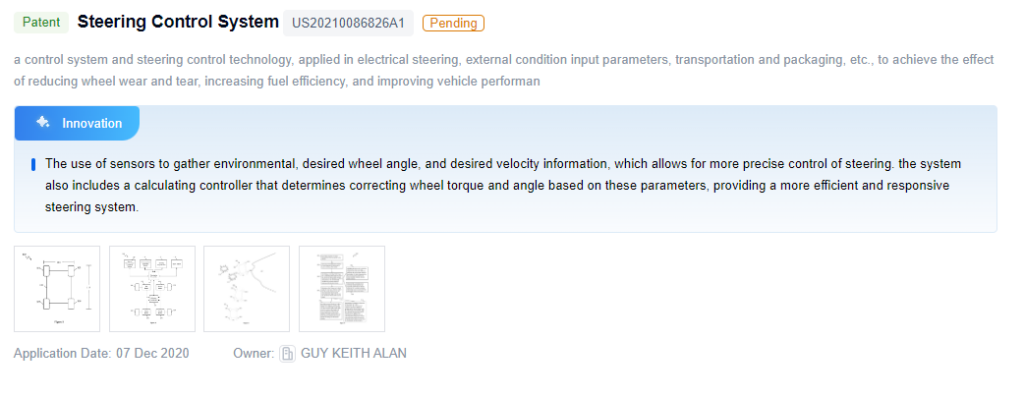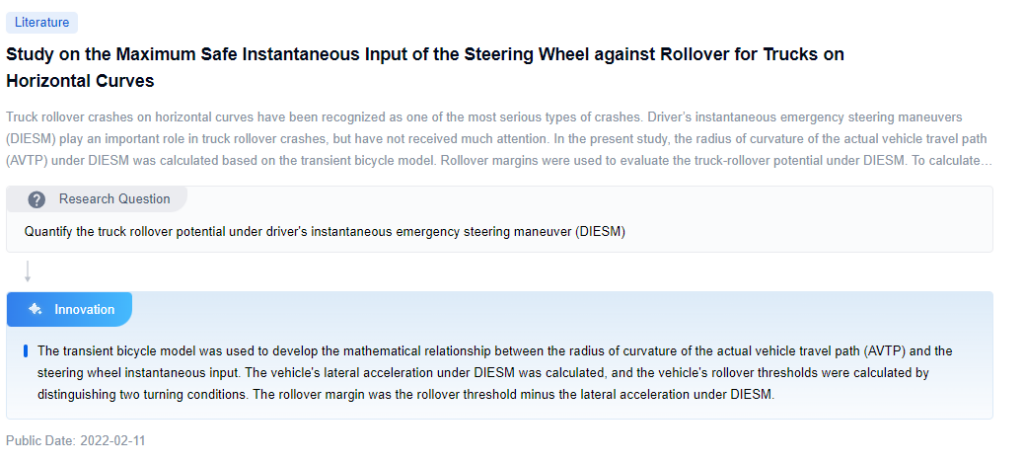
Technical Background and Objectives for Automated Steering Wheels
The development of steering wheels for highly automated vehicles is driven by the need for enhanced safety and performance. As vehicles become more autonomous, the steering wheel’s role is evolving from a primary control interface to a secondary input device and potential safety backup. The main objective is to design steering wheels that can seamlessly transition between autonomous and manual driving modes, ensuring optimal control in both scenarios. Key goals include improving steering feel, integrating haptic and visual cues, and developing fail-safe mechanisms for smooth transitions. Ergonomics and intuitive controls are also crucial to enhance driver comfort and reduce fatigue during extended manual operation.

To get a detailed scientific explanations of steering wheel, try Eureka.
Market Demand for High Automation Vehicle Steering Systems
The market demand for high automation vehicle steering systems is fueled by the growing adoption of advanced driver assistance systems (ADAS) and autonomous driving technologies. These systems are essential for ensuring safe and reliable operation, particularly in complex driving scenarios.
Safety and Efficiency
- Safety Emphasis: The demand is driven by the need to reduce accidents caused by human error. Automated steering systems can respond faster and more accurately than human drivers, potentially preventing collisions and improving road safety.
- Efficiency and Comfort: Consumers seek convenience and comfort, especially in traffic jams or long-distance driving. Automated systems offer a more relaxed experience by taking over steering responsibilities.
Sustainability and Technological Advancements
- Sustainability: The push for sustainability and energy efficiency in the automotive industry contributes to the demand for these systems, which optimize steering inputs and vehicle dynamics for better fuel efficiency.
- Technological Growth: The market is expected to grow significantly as ADAS and autonomous driving technologies become more prevalent across various vehicle segments, including passenger cars and commercial vehicles.
Current State and Challenges in Automated Steering Technology

Automated steering technology has advanced significantly, but several challenges remain to ensure performance and safety.
Sensor Fusion and Control Algorithms
- Sensor Integration: Automated steering systems rely on multiple sensors (cameras, radar, LiDAR) to perceive the environment. The challenge lies in fusing data from these sensors and ensuring consistent interpretation, especially in dynamic scenarios.
- Advanced Control: Developing control algorithms that handle various driving conditions is complex. These algorithms must navigate different road geometries, traffic patterns, and environmental conditions while maintaining precise control.
Cybersecurity and System Integration
- Cybersecurity: As vehicles become more connected, the risk of cyber threats increases. Ensuring the security of the steering system’s software and communication channels is crucial.
- System Coordination: Integrating steering systems with braking and powertrain systems adds complexity, requiring seamless coordination for safe operation, especially during complex maneuvers or emergencies.
Evolution Path of Automated Steering Systems

Current Solutions for Automated Steering Performance and Safety
Steer-by-Wire Systems
Steer-by-wire systems eliminate the mechanical connection between the steering wheel and wheels, using electronic signals to control steering. These systems offer improved control and safety, with features like differential braking and redundant components for fault tolerance.
Four-Wheel Steering Systems
Four-wheel steering systems enhance maneuverability and handling by allowing the rear wheels to steer. These systems adjust based on vehicle speed and other factors to improve stability and performance.
Safety Features and Performance
Various safety features are integrated into steering systems, including backup systems, steering angle limiters, and fail-safe modes. These features prevent loss of control and ensure reliable operation under different conditions.
Key Players in Automated Vehicle Steering Industry
The competitive landscape for automated vehicle steering technology is rapidly evolving, with key players leading advancements in performance and safety.
Toyota Motor Corp.
Toyota has developed an advanced steering wheel system for automated vehicles that integrates AI and sensor technologies to enhance both performance and safety.
Continental Automotive Systems (Shanghai) Co. Ltd.
Continental has created a smart steering wheel system using machine learning algorithms to predict and respond to driver behavior, incorporating haptic feedback and advanced ergonomics.
Ford Global Technologies LLC
Ford focuses on integrating biometric sensors into their steering wheel technology, monitoring driver health and readiness, and taking over control in case of driver incapacitation.
Hitachi Astemo Ltd.
Hitachi Astemo has introduced a steering system combining high-precision actuators with AI-driven control algorithms, providing seamless transitions between manual and automated driving modes.
Robert Bosch GmbH
Bosch offers a state-of-the-art steering system designed for automated vehicles, featuring redundant systems for enhanced safety and real-time data processing for precision control.
Here’s the seventh section with “Key Points” on a separate line from the description:
Here’s the seventh section with “Key Points” formatted with bullet points and descriptions bulleted as requested:
Core Innovations in Automated Steering Technology
Patent 1: Passenger Side Driving Instructor Brake Controller
- Key Points:
- This system allows the instructor to control both steering and braking from the passenger seat.
- It features a telescoping shaft with a brake lever connector, which is customizable for different vehicles.
- The system includes a padded handle for comfortable use by the instructor.

Patent 2: Steering Control System
- Key Points:
- The system integrates sensors to collect data on the environment, wheel angle, and velocity, enabling precise steering control.
- It efficiently adjusts wheel torque and angle for responsive handling.

Paper 1: Maximum Safe Instantaneous Input of Steering Wheel Against Rollover
- Key Points:
- It develops methods to calculate rollover thresholds and safety margins under various turning conditions.resholds and safety margins under various turning conditions.
- This study analyzes truck rollover risks during emergency maneuvers.

Future Research Directions for Automated Steering Systems
Steer-by-Wire Systems
Steer-by-wire systems eliminate the mechanical connection between the steering wheel and wheels, allowing for improved performance, safety, and control through electronic sensors and actuators.
Four-Wheel Steering Systems
Four-wheel steering systems enable the steering of both front and rear wheels, improving maneuverability, stability, and handling performance, particularly at low speeds or tight turns.
Safety Features and Performance Evaluation
Various safety features and performance evaluation methods are essential for ensuring the reliability and safety of steering systems, particularly for advanced systems like steer-by-wire.
Regulatory and Safety Standards for Automated Steering
Regulatory and safety standards are crucial for ensuring the safe operation of automated steering systems. These standards focus on reliability, redundancy, cybersecurity, and human-machine interaction to mitigate potential risks and ensure compliance with industry best practices.
Environmental Impact of Automated Steering Technologies
Automated steering technologies have the potential to reduce fuel consumption and emissions by enabling more efficient driving patterns. However, the environmental benefits depend on the energy sources used and the sustainability of production and disposal practices for the advanced components required.
If you want an in-depth research or a technical report, you can always get what you want in Eureka Technical Research. Try now!

